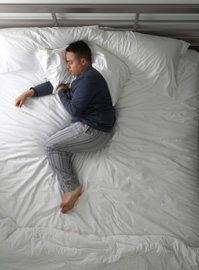Good Sleeping Posture Helps Your Back
Most everyone knows that good posture is important. But good posture doesn't apply just to sitting and standing. The muscles and ligaments of your back relax and heal themselves while you sleep. In order to protect your back, good posture is important while sleeping.
Here are some tips to help you sleep better:
Choosing a mattress
Little scientific research exists on which mattress is best for back pain or for maintaining a healthy back. The mattress that's right for you lets you wake up feeling rested and free of pain or soreness. Unless you have a condition that may need a certain type of mattress, you should choose a mattress that provides support for the natural curves of your spine and is comfortable.

The best mattress is one that allows you to sleep soundly and without pain.
If you sleep with a partner, you should have enough space to move into a comfortable sleeping position. Consider replacing your mattress every 6 to 8 years, according to the National Sleep Foundation. If you have a back problem, ask your healthcare provider or physical therapist to advise the type of mattress that would be best for you.
The right pillow
Pillows are not just for your head and neck. Depending on your sleeping position, additional pillows can help keep your spine in the correct position. The pillow for your head should support the natural curve of your neck and be comfortable. A pillow that's too high can put your neck into a position that causes muscle strain on your back, neck, and shoulders. Choose a pillow that will keep the neck aligned with the chest and lower back. Your pillow should be adjustable to allow you to sleep in different positions. Replace your pillows every year or so.
Alignment
Regardless of your sleeping position, try to keep your ears, shoulders, and hips aligned:
-
If you sleep on your back, a small pillow under the back of your knees will reduce stress on your spine and support the natural curve in your lower back. The pillow for your head should support your head, the natural curve of your neck, and your shoulders.
-
Sleeping on your stomach can create stress on the back because the spine can be put out of position. Placing a flat pillow under the stomach and pelvis area can help to keep the spine in better alignment. If you sleep on your stomach, a pillow for your head should be flat, or sleep without a pillow.
-
If you sleep on your side, a firm pillow between your knees will prevent your upper leg from pulling your spine out of alignment and reduce stress on your hips and lower back. Pull your knees up slightly toward your chest. The pillow for your head should keep your spine straight. A rolled towel or small pillow under your waist may also help support your spine.
-
Insert pillows into gaps between your body and the mattress.
-
When turning in bed, don't twist or bend at the waist. Instead move your entire body as one unit. Keep your belly pulled in and tightened, and bend your knees toward the chest when you roll.
-
Keep your ears, shoulders, and hips aligned when turning as well as when sleeping.